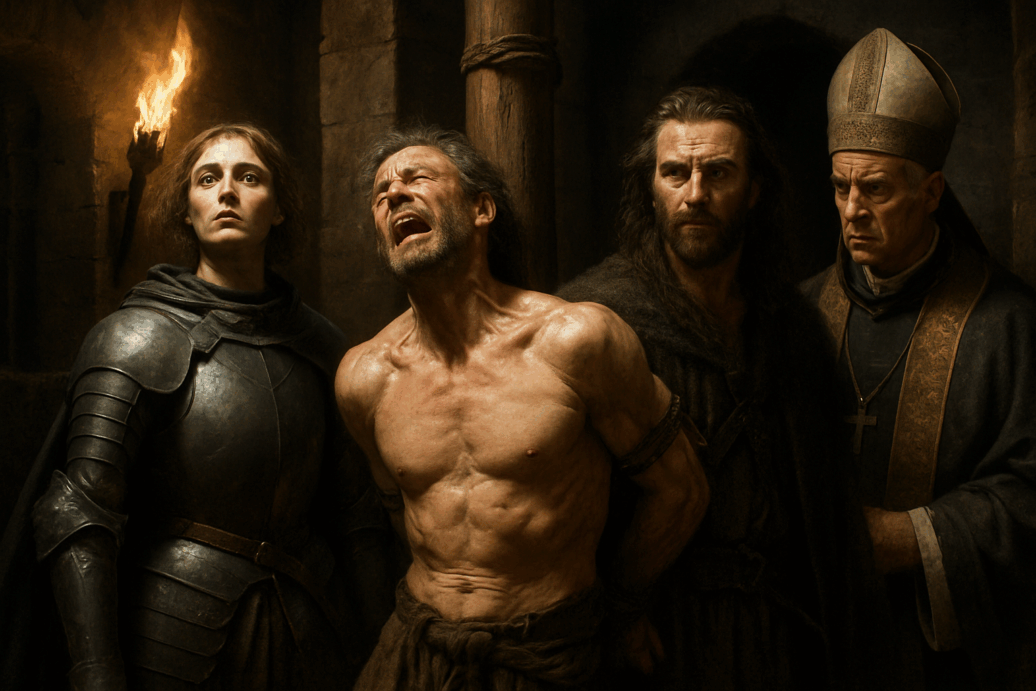The medieval era is often remembered for its knights, castles, and kings, but beneath the romance lies a grim reality of imprisonment, confession under duress, and brutal public execution. Among the thousands who suffered were not only nameless peasants but also famous people tortured in medieval times — individuals whose names endured through history, etched in stories of injustice and brutality. This page explores the lives of those well-known figures who met pain in dungeons, trials, and chambers across Europe.
Joan of Arc: A Saint Burned for Heresy
Perhaps the most recognized of all tortured saints in medieval history, Joan of Arc was a young French peasant girl who claimed divine guidance in leading armies during the Hundred Years’ War. Captured and handed over to the English, she was subjected to a sham trial for heresy, endured psychological torture, and was ultimately burned at the stake in 1431. Her fate remains one of the most infamous famous executions in the Middle Ages.
William Wallace: The Rebel Who Was Broken
Immortalized in the film Braveheart, Scottish leader William Wallace led resistance against English rule. After his capture, Wallace was found guilty of treason and suffered a gruesome execution by hanging, drawing, and quartering — a method designed for maximum pain and humiliation. His story exemplifies the medieval torture of political figures and the punishment of rebellion.
Thomas Becket: A Royal Conflict Turned Tragedy
Thomas Becket, the Archbishop of Canterbury, was once a close friend of King Henry II. But after opposing royal interference in church affairs, Becket was brutally murdered by four knights in Canterbury Cathedral in 1170. While not tortured in the traditional sense, his martyrdom became a symbol of royal punishment for those who dared defy the crown.
Girolamo Savonarola: The Monk Who Challenged the Pope
A Dominican friar in Florence, Savonarola gained fame for preaching against the corruption of the Church. When he lost favor with the Pope, he was arrested, tortured repeatedly on the rack, and publicly executed by hanging and burning. He is one of the most prominent historical figures who were tortured for challenging the religious order.
Marguerite Porete: A Philosopher Burned for Her Beliefs
An intellectual mystic and writer, Marguerite Porete was accused of heresy for her book The Mirror of Simple Souls. After refusing to recant her views, she was burned at the stake in 1310. Her case shows how even philosophical expression could lead to royal retribution and fatal punishment.
Gilles de Rais: From Hero to Horror
A former companion of Joan of Arc, Gilles de Rais was a nobleman who fell from grace and was later accused of horrific crimes, including the abduction and murder of children. Tried by both the Church and the state, he was tortured, confessed, and hanged. His case reflects both the extremes of medieval suffering and the ambiguous line between guilt and political convenience.
The Spanish Inquisition and Its Noble Victims
The Inquisition is infamous for its use of torture to extract confessions, and it didn’t spare the highborn. Noblemen tortured during inquisition included financiers, scholars, and even royals accused of false conversions or heresy. Their fates unfolded in torture chambers designed for secrecy and suffering.
To witness chilling reconstructions of the era’s most feared devices, visit the Medieval Torture Museum in Chicago, where exhibits vividly portray the instruments used to extract pain and confession.
Royal Blood, Real Pain: The Torture of Monarchs
While rulers often ordered the torture of others, they weren’t always immune. Deposed royals and disgraced nobles were sometimes imprisoned, starved, or even executed under grisly conditions. Royals who were tortured include monarchs caught in shifting alliances, such as Edward II of England and Richard III’s enemies.
Learning Through Pain: Museums That Preserve the Truth
Curious about medieval torture victims and the cruel tools used against them? The Medieval Torture Museum in LA offers haunting experiences of dungeons and historic trials that paint vivid pictures of suffering throughout the ages. These immersive spaces blend dark history with education.
If you’re looking for places to visit in LA that combine culture, history, and atmosphere, this museum provides a powerful reminder of what justice once looked like — and how far society has come.
You can also explore another captivating location at the Medieval Torture Museum in Saint Augustine, one of the most immersive and reflective experiences of the cruelty inflicted during medieval times.
Stay Curious: Explore More on Our Blog
To uncover more detailed stories of celebrities tortured in history, obscure cases, and in-depth analysis of the devices that changed lives forever, be sure to follow our blog. Every article explores another piece of this chilling puzzle.
Final Thoughts: Remembering the Suffering Behind the Legends
These famous deaths in medieval torture chambers are more than just historical footnotes. They are reminders of how power, belief, and politics often collided in terrifying ways. From saints to scholars, rebels to royals, the stories of those who suffered highlight the human cost of fear-driven rule. Their voices echo through history — not as statistics, but as symbols of resistance, tragedy, and the enduring will to be heard.






